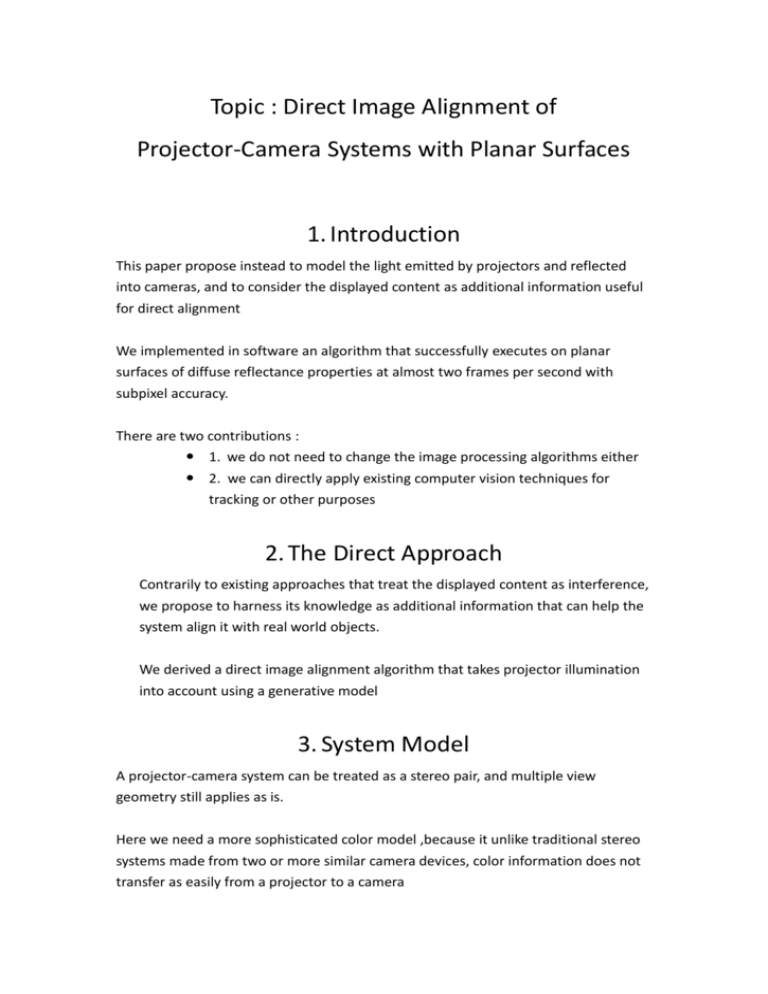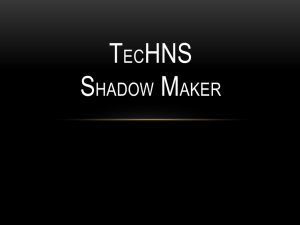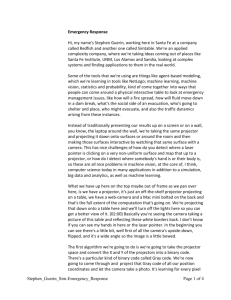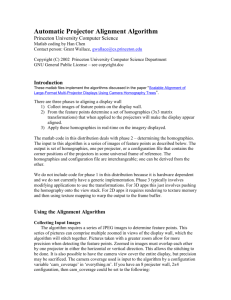DOC
advertisement

Topic : Direct Image Alignment of Projector-Camera Systems with Planar Surfaces 1. Introduction This paper propose instead to model the light emitted by projectors and reflected into cameras, and to consider the displayed content as additional information useful for direct alignment We implemented in software an algorithm that successfully executes on planar surfaces of diffuse reflectance properties at almost two frames per second with subpixel accuracy. There are two contributions : 1. we do not need to change the image processing algorithms either 2. we can directly apply existing computer vision techniques for tracking or other purposes 2. The Direct Approach Contrarily to existing approaches that treat the displayed content as interference, we propose to harness its knowledge as additional information that can help the system align it with real world objects. We derived a direct image alignment algorithm that takes projector illumination into account using a generative model 3. System Model A projector-camera system can be treated as a stereo pair, and multiple view geometry still applies as is. Here we need a more sophisticated color model ,because it unlike traditional stereo systems made from two or more similar camera devices, color information does not transfer as easily from a projector to a camera 3.1 Simplifying Assumptions The projector and camera are fixed together, like a typical stereo camera, implying that the strong epipolar constraint applies. The color responses of both camera and projector must be linear with respect to the light intensity 3.2 Geometric Model To model geometrically both camera and projector devices, we use the familiar pinhole camera model , it maps a 3D point x3 of the surface to a 2D point on the image plane of the device x2 = K3×3 ( R3×3x3 + t3 ) (1) It follows that the projection onto the image planes of a camera placed at the origin and of a calibrated projector can be respectively written xc = Kc ( I x3 +0) (2) xp = Kp ( Rpx3 + tp ) (3) 3.3 Color Model Here we decided instead for simplicity to model only the relationship between devices. We wanted a model that we could calibrate without camera control and with only one projector and a planar surface If a projector pixel shines the color pp on a surface point of reflectance ps, we expect the corresponding camera pixel to observe the color pc = ps × [ gX3×3pp + a ] + b (4) g : the gain of the projector light X : the color mixing matrix b : the noise bias of the camera a : the ambient light All vectors are three-vectors in the RGB color space, and their multiplication is done element-wise. 3.4 Calibration These models require a number of parameters to be known, which we can find via calibration. Assume linearized color responses from the start , We proceed in a manner similar to current methods for both geometric parameters (Kc, Kp, Rp, and tp) and color parameters (X and b) 3.5 Image Formation Model Using the geometric and color models, we can simulate how an image forms on the sensor of the camera Assuming the geometric parameters n of the plane are known and given a 3D point x3 on the surface plane such that nTx3 + 1 = 0 xp = Kp ( Rpx3 + tp ) = Kp ( Rpx3 − tpnTx3 ) = Kp ( Rp − tpnT ) x3 (5) T −1 = Kp ( Rp − tpn ) K xc = Hpc xc From this we define the warping function from the camera image plane to the one of the projector: wp(xc) ≡ Hpc xc (6) The camera motion Rs, ts required to return to the prior orientation and position can be seen as a second camera with the same set of internal parameters, but with different external parameters , but with different external parameters, as follows xs = Kc ( Rsx3 + ts ) = Kc ( Rsx3 − tsnTx3 ) = Kc ( Rs − tsnT ) x3 (7) = Kc ( Rs − tsnT ) K−1 = Hsc xc ws(xc) ≡ Hsc xc (8) Finally, plugging these coordinates into the color model of Equation 4 by considering the pixel colors pc, ps, and pp as functions over the images, we expect the pixel color at point xc of the camera to be pc(xc) = ps(ws(xc)) × [ gXpp(wp(xc)) + a ] + b (9) 4. Alignment Algorithm Based on the mentioned simplifying assumptions, the models illustrated above, and the parameters obtainable via calibration, we designed an iterative method to directly align images of projector-camera systems. Here we explain the cost function and the algorithm to minimize it, which can hopefully converge to the correct alignment under normal circumstances 4.1 cost function Four others come from the gain g and the ambient light a, which we assumed may change during motion, for a total of ten degrees of freedom and consequently ten parameters to optimize. 4.2 Minimization To minimize the cost function of Equation 10, while one could optimize the 3D motion parameters directly, because of the inherent ambiguity between 3D rotation and translation, the convergence properties lack robustness To gain more robustness, we implemented constrained Gauss-Newton optimization using a Lagrange multiplier to limit results to physically possible transformations. || H sc K c ( Rs ts nT ) K c1 ||F 0 For simplicity and contrarily to Lucas and Kanade Algorithm, we decided to evaluate the Jacobians numerically. This avoids the need to precompute image gradients and to analytically derive the cost function 4.3 Initialization The above minimization algorithm works only if the surface plane parameters n are known. We designed an approach that can cope with small movements, allowing users to hold the surface plane in their hands. This approach works in three phases : 1. First estimating the ambient light a, then the reflectance map ps and finally the geometric plane parameters n. It starts by the projection and the capture as fast as possible of three consecutive shots, to obtain images with the smallest interframe motion possible, from which the user may select a region of interest. Taking the first two images, it can then estimate the ambient light by defining the reference gain g = 1 and isolating a from 1 max pc b a Xp p pc2 pc1 2. Second phase consists of using the second image, this time the original crisp version, along with the estimated ambient light to recover a crisp reflectance map pc2 b ps Xp max a p 3. Third phase, the idea is to actually run the minimization algorithm described in the previous subsection, optimizing not only for g, Hsc and a, but also for n. For the algorithm to converge properly though, some sort of texture needs to be displayed on the surface plane. More formally, assuming epipolar lines aligned with the x-axis, the intensities assigned to the projector image for coordinates x [ x1 , x2 ] equal : Finally, because of user motion the resulting plane parameters n might be slightly off from the values in the second image, from which the system actually derives the reflectance map ps. 5. Experiment Result We conducted two sets of experiments : 1. measure accuracy quantitatively by comparing alignment results with easy to detect markers 2. demonstrate real-time operation and support for arbitrary textures On each frame, we left our algorithm run until ten iterations in a row did not lower the error of Equation 10 by more than 10%, taking on average The total root mean square error (RMSE) sums up to 0.33 pixels, which even includes portions of motion blur and images violating the assumed single gain g, especially true of slanted planes . 6. Conclusion To accelerate it, we plan on investigating mathematical approximations, algorithmic tricks, as well as hardware related optimizations. Apart from these limitations, the algorithm can also be enhanced to support more complex 3D surfaces, for example by using a piecewise planar model and aligning multiple planes simultaneously 7. Reference [1]http://www.ok.ctrl.titech.ac.jp/~saudet/research/procamtracker/ [2] D. Bandyopadhyay, R. Raskar, and H. Fuchs. Dynamic Shader Lamps: Painting on Movable Objects. In Proceedings of the IEEE and ACM International Symposium on Augmented Reality (ISAR’01), page 207. IEEE Computer Society, 2001. [3] R. Raskar, J. van Baar, P. Beardsley, T. Willwacher, S. Rao, and C. Forlines. iLamps: Geometrically Aware and Self- Configuring Projectors. In Proceedings of ACM SIGGRAPH 2003, pages 809–818. ACM, 2003.








